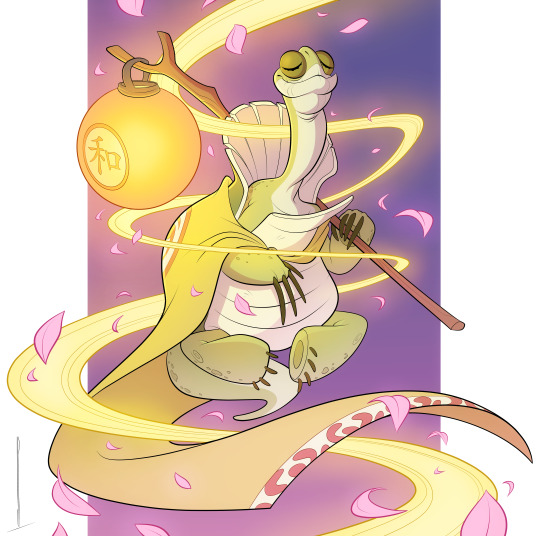#turtle
Text

(source)
546 notes
·
View notes
Text

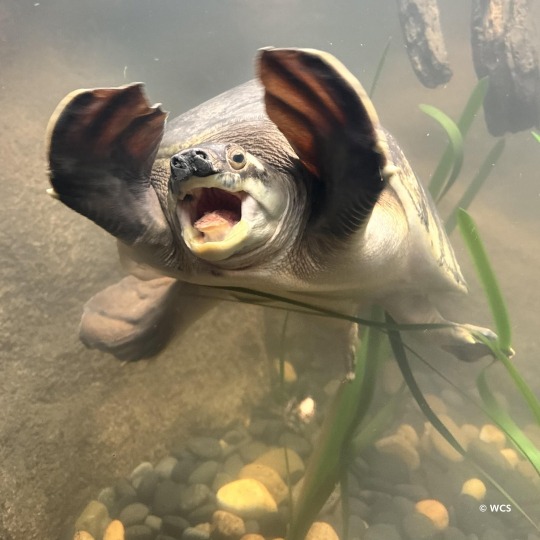
Pig-nosed Turtle (Carettochelys insculpta), juvenile, family Carettochelyidae, found in northern Australia and southern New Guinea
ENDANGERED.
These turtles have no scales, and thus have a leathery shell. Its shell is made of bone, however, unlike “softshell turtles” in the family Trionychidae.
photograph by Wildlife Conservation Society
Bronx Zoo
#softshell turtle#turtle#carettochelys#carettochelyidae#reptile#herpetology#animals#nature#australia#new guinea
346 notes
·
View notes
Text

24K Polar Puff Swifty Turtle Plush
#png#transparent#kidcore#nostalgia#nostalgiacore#toycore#toywave#toys#green#yellow#plushie#plush#stuffed animals#stuffies#turtles#turtle
85 notes
·
View notes
Text
Some turtle oc drawings


Turtle with glasses (Oli) by @pegibruno
#my art#rottmnt#turtles#rottmnt ocs#rottmnt oc#rottmnt au#my ocs#rise oc#yokai oc#tmnt oc#oc#oc art#ocs#turtle oc#turtle#rise of the teenage mutant ninja turtles#rottmnt fandom
115 notes
·
View notes
Text
#ruby rose#liminal space#padfoot#davekat#konosuba#turtle#eleven#stayc#ranboo#sokka#aot smut#sharing wife#smosh#仁藤りさ#ootd
125 notes
·
View notes
Text
#mlk#risa yukihira#nerd#eclectic witch#chat blanc#turtle#gouache#felice fawn#alec lightwood#brainwashing#ymcmb#loona
120 notes
·
View notes
Text
Wet Beast Wednesday: spiny softshell turtle
It may be neither Flat Fuck Friday nor Turtle Tuesday, but because this is my series and I can do what I want, I'm talking about a very flat turtle. The spiny softshell turtle (Apalone spinifera) is the most widely distributed and possibly the most common softshell turtle in North America. Its range covers most of the Eastern half of the USA and stretched into Canada and Mexico. There are 6 subspecies separated by geography and hybridization can happen in places where their ranges cross. Hybridization has also been known to happen with the Florida softshell (Apalone ferox). The subspecies are the northern (A. s. spinifera), gulf coast (A. s. aspera), Texas (A. s. emoryi), pallid (A. s. pallida), Guadalupe (A. s. guadalupensis), and black (A. s. atra) spiny softshells.

(Image: a spiny softshell turtle seen from above and to the side. It is a turtle with a wide, flat shell. Its head and one foot are visible. The head is skinny and has an elongated nose. The foot is wide and flat, with webbed toes. The turtle is an olive green with black dots on the skin, yellow stripes on the face, and dark spots on the shell. End ID)
The thing that makes a softshell a softshell is the lack of keratinized scutes on their shells. This makes the shells smooth and leathery. The center of the shell has a layer of solid bone user it, but this does not extend to the edges of the shell, making it less rigid. Softshells are the fragile speedsters of the turtle world. Their shells are a lot lighter and often more streamlined, allowing for faster movement both on land and in water, but they provide less defense. Spiny softshells have spiny projections along the front edge of the carapace (upper shell), with males having more than females. They are some of the largest North American freshwater turtles. Females can reach a carapace length of 54 cm (21 in) and 11 kg (25 lbs) while the smaller males max out at about 25 cm (10 in).
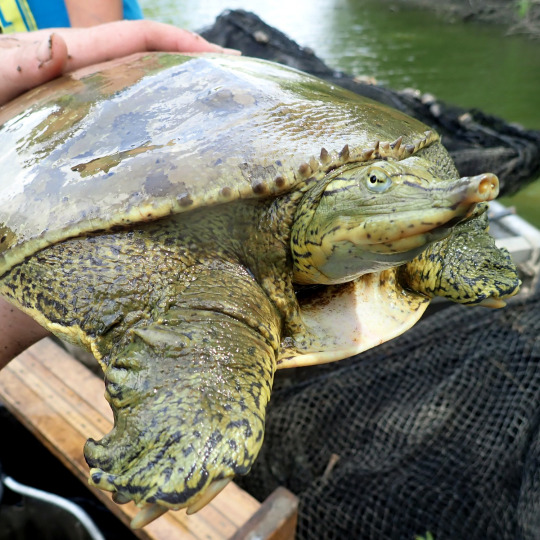
(Image: a spiny softshell being held by a person, seen from the front. The leading edge of the carapace is visible, showing off the small spines. End ID)
Spiny softshells have wide, flat, paddle-like feet with three claws and an elongated nose that acts like a snorkel. The turtles are born a bright olive color with striped faces and dark spots on the shell. Males keep their juvenile coloration for their entire lives while females grow darker ad lose many of their markings. It can be very difficult to tell females of different subspecies apart, while males and juveniles can be distinguished by their markings. Smooth skin and highly vascularized membranes in the cloaca, mouth, and throat allow the turtles to breathe by diffusing dissolved oxygen from the water into their blood.
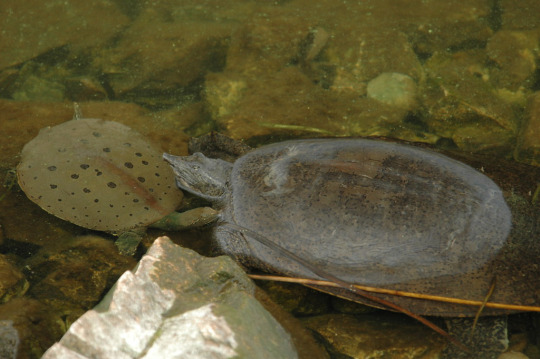
(Image: a male and female spiny softshell facing each other. The male is less than half the size of the female and has an olive colored shell and skin, with dark spots on the shell. The female is a uniform muddy brown color. End ID)
Spiny softshells are generalists able to live in a wide range of habitats. They prefer streams, rivers, and ponds with muddy or sandy bottoms and high visibility, but can live in most freshwater habitats. Softshells are diurnal, spending their days basking and feeding. Being turtles, they are ectothermic, meaning their body temperature matches the surrounding temperature. To warm themselves up, the turtles bask in the sunlight. They can often be found resting on exposed rocks, logs, sandbars, or shorelines. While not particularly social animals, the turtles will bask in groups. When threatened, softshells will attempt to swim away and/or bury themselves. In the right sediment, a softshell can bury itself in under a second. Because their shells are less rigid, softshells have to actively defend themselves when cornered and will bite and scratch. People have to be careful when handling them. They brumate (that's hibernation for reptiles) during winter. While brumating, they bury themselves underwater and slow their metabolism and oxygen requirements. In this state they can fully sustain themselves on oxygen absorbed through their skin or special membranes.
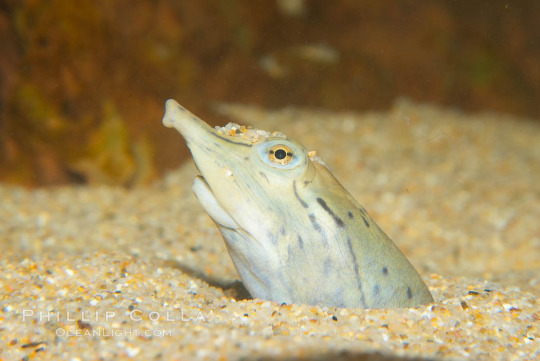
(Image: a spiny softshell turtle buried in its hunting strategy. Only the head is visible above the sand. End ID)
They are primarily carnivores and will eat anything that can fit in their mouths. Aquatic insects, crayfish, worms, amphibians, mussels, snails, fish, and more are on their plate. While capable of fast swimming, they are not pursuit predators. They employ two primary hunting strategies. The first is to bury themselves in the sediment and wait for prey to come by. The second is digging in the sediment to find worms and other animals. Fish have been known to follow digging turtles around to feed on animals unearthed by them.

(Image: a spiny softshell in captivity. It is swimming at the surface of the water in a tank, amongst artificial leaves. End ID)
Spiny softshells mate in spring. Males attempt to woo females by swimming over to them and bumping heads together. The male then sits on top of the female to mate. Unlike most species of turtles, the males do not grab onto the female's shells during mating. Eggs are laid between summer and early fall and will hatch next spring. The female will dig a nest in sandy or gravelly banks and bury the eggs once they have been laid. She provides no further care. Females will typically mate multiple times each year, with each mating having a different nest. The juveniles take 8 to 10 years to reach sexual maturity and they can live up to 50 years in the wild. Many turtles determine sex by the temperature the eggs are incubated in. This is not the case with spiny softshells, who have genetics based sex determination.

(Image: a group of 5 juveniles. The photo focuses on two who are sitting next to each other. One has its front right leg on the shell of the other. They have similar coloration to an adult male. End ID)
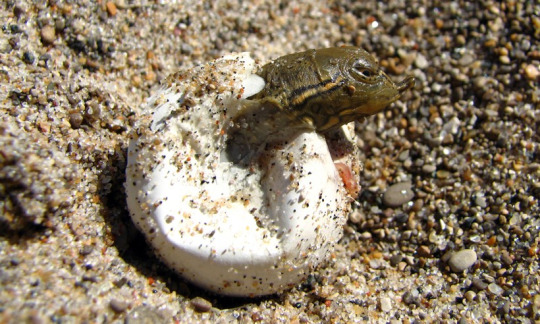
(Image: a newborn emerging from its egg. The egg is round and white, looking like a ping-pong ball. Only the head of the turtle has emerged. End ID)
Most subspecies of spiny softshell are classified as least concern or near threatened by the IUCN, meaning they are not in danger of extinction. The exception is the black spiny softshell, also known as the Cuatro Ciénegas softshell, which is critically endangered. The primary threats to the turtles is habitat loss due to human activity. Adults have no natural predators outside of the Florida and adjacent state populations, which are prey to alligators. Juveniles are eaten by a variety of animals including fish, snakes, raccoons, and herons. People will also eat the adults. Because it can take a whole decade for juveniles to become reproductive, losses in population take a long time to replace. They have been introduced to areas outside of their native range, most notably the western USA. Most of these introductions are due to people releasing pet turtles into the wild.
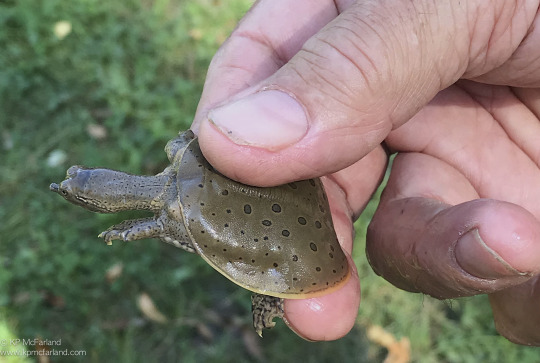
(Image: someone holding a juvenile. The shell is 2-3 times the size of the human's thumb. End ID)
#i typoed it as softhsell more times than I care to admit#wet beast wednesday#turtle#turtles#softshell turtle#soft shell turtle#spiny softshell turtle#reptile#biology#zoology#ecology#animal facts#freshwater ecology#aquatic biology#informative#educational#image described#turtle power#herpetology
52 notes
·
View notes
Text
Good turt
62K notes
·
View notes
Photo

[Submission] Day 836: 🐢 & 🍓
23K notes
·
View notes
Text

(source)
155 notes
·
View notes
Text
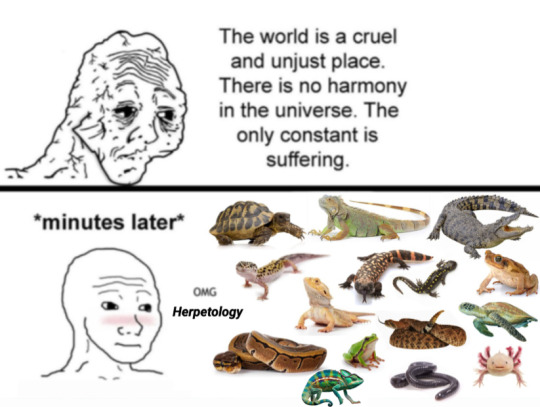
#indora talks#Ashshshfjdjsjfkfkfkd#Cute little guys#Love them#herpetology#Reptiles#amphibians#Snake#Frog#Turtle#Tortoise#Viper#Toad#Caecilian#Axolotl#Bearded dragon#Gecko#Iguana#Gila monster#Crocodile#salamander#Biology#Animals#Memes
5K notes
·
View notes
Text

Water Lily Turtle - Botanimal Portrait
.
If you like what I do and you would like to support my artwork, I am on Patreon and I have an Etsy Shop.
5K notes
·
View notes
Text

Timmy Turtle
Ko-fi / Instagram
#stuffed animals#stuffies#stuffed animal#jellycat#jellycats#jellycatstuffies#jellycatplush#jellycatlondon#jellycat stuffed animals#cute#turtle#turtles#reptile#reptiles#plush#plushies#plushie#plushblr#plushcore#plushiecore#stuffiecore#plush blog#allplush#plush toy#plush toys#soft toy#soft toys#toycore#kidcore#plush animal
17K notes
·
View notes

